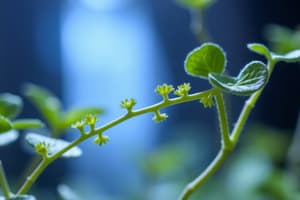Podcast
Questions and Answers
What is a photoautotroph, and how is it a type of autotroph?
What is a photoautotroph, and how is it a type of autotroph?
Photoautotrophs are organisms that can make their own energy using light and carbon dioxide via the process of photosynthesis.
What types of organisms might be in the photoautotroph category?
What types of organisms might be in the photoautotroph category?
Green plants and photosynthetic bacteria.
Is algae a type of plant?
Is algae a type of plant?
True (A)
Where do the reactions of photosynthesis take place?
Where do the reactions of photosynthesis take place?
What are the wavelengths of visible light?
What are the wavelengths of visible light?
Why are accessory pigments important?
Why are accessory pigments important?
Why is the structure of chlorophyll important in regards to where it is located in a chloroplast?
Why is the structure of chlorophyll important in regards to where it is located in a chloroplast?
Why do pigments appear colored?
Why do pigments appear colored?
How do NADP+ and NADPH relate to each other?
How do NADP+ and NADPH relate to each other?
Flashcards are hidden until you start studying
Study Notes
Photoautotrophs
- Photoautotrophs are organisms that produce energy through photosynthesis, using light and carbon dioxide.
- The term combines "auto" (self) and "photo" (light), indicating self-sufficient energy production.
Examples of Photoautotrophs
- Green plants and photosynthetic bacteria are primary examples of photoautotrophs.
Algae Classification
- Algae are plant-like organisms containing chlorophyll and pigments to capture light.
- They can be unicellular or multicellular and store energy as carbohydrates.
Photosynthesis Location
- Photosynthesis occurs in chloroplasts, primarily located in the mesophyll layer of plant leaves.
Wavelengths of Visible Light
- Visible light wavelengths range from approximately 400 to 710 nanometers.
- Shorter wavelengths have greater energy, making blue light more energetic than red light.
Importance of Accessory Pigments
- Accessory pigments like carotenoids absorb light wavelengths that chlorophyll misses, enhancing photosynthesis range.
- They protect chlorophyll by stabilizing unpaired electrons, preventing damage from free radicals.
Structure of Chlorophyll
- Chlorophyll is abundant in thylakoid membranes within chloroplasts, essential for absorbing light.
- It reflects green light, leading to the characteristic green color of plants.
Color of Pigments
- Pigments' colors result from reflected wavelengths; different pigments absorb varying wavelengths.
- Chlorophyll absorbs blue and red light, reflecting green, while carotenoids absorb blue and green, appearing yellow, orange, or red.
Role of NADP+ and NADPH
- NADP+ and NADPH participate in redox reactions during photosynthesis, linking light energy capture to energy transfer processes.
Studying That Suits You
Use AI to generate personalized quizzes and flashcards to suit your learning preferences.




